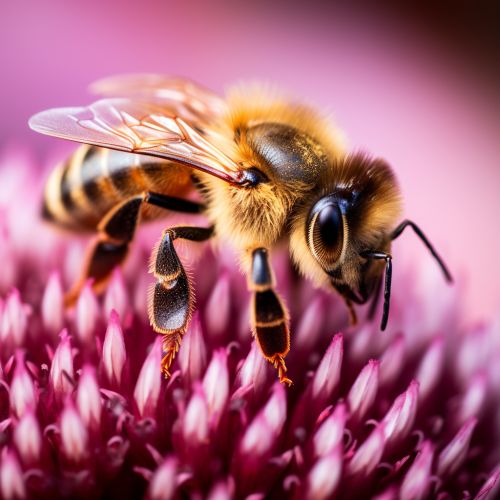Honey bee life cycle
Introduction
The Honey bee's life cycle, like that of all insects, includes multiple stages: egg, larva, pupa, and adult. The details of this life cycle vary significantly among the different species of bees, but all bees undergo these four stages. This article will focus on the life cycle of the honey bee, a species of bee that has been extensively studied due to its importance in agriculture and nature.
Egg
The life cycle of a honey bee begins when the queen bee lays an egg. The queen bee has the ability to control the sex of the eggs she lays. She can lay either fertilized or unfertilized eggs. Fertilized eggs will develop into female bees, either worker bees or potential future queens, while unfertilized eggs will develop into male bees, known as drones.
Larva
After three days, the egg hatches into a larva. The larva is a small, white, legless grub that is fed by worker bees. The larva undergoes five stages of growth, known as instars, during which it grows rapidly. This rapid growth is facilitated by the consumption of royal jelly, a protein-rich secretion from the glands of worker bees, for the first few days of its life. After that, the larva's diet transitions to honey and pollen, also known as bee bread.
Pupa
After about six days, the larva spins a cocoon around itself and becomes a pupa. During this stage, the pupa undergoes a dramatic transformation, known as metamorphosis, during which it develops the wings, legs, eyes, and other adult structures. The length of the pupal stage varies depending on the type of bee that the pupa will become. For worker bees, the pupal stage lasts about 12 days, while for drones and queens, it lasts about 14 and 7.5 days, respectively.
Adult
The final stage of the honey bee life cycle is the adult stage. After emerging from the pupa, the adult bee begins its life's work. For worker bees, this involves a variety of tasks, including cleaning the hive, feeding the larvae, and foraging for food. Drones, on the other hand, have only one task: to mate with a queen. After mating, drones die. Queens, after emerging from their cells, will either take over the existing hive or leave with a swarm of workers to start a new hive.


Role of the Queen
The queen bee plays a crucial role in the life cycle of a honey bee. She is the mother of all bees in the hive and is responsible for laying the eggs that will become the next generation of bees. The queen bee is the only bee in the hive that is capable of laying fertilized eggs. She mates only once in her life, storing the sperm from the drones she mates with in a special organ called the spermatheca. She uses this stored sperm to fertilize her eggs throughout her life, which can last several years.
Role of the Worker Bees
Worker bees also play a vital role in the honey bee life cycle. They are responsible for feeding and caring for the larvae, cleaning the hive, and foraging for food. Worker bees are all female, and they are the bees that people most commonly see flying around outside the hive. Worker bees have a variety of tasks throughout their lives, which can last several weeks to months. These tasks are divided into two main categories: inside work and outside work. Inside work includes cleaning the hive and feeding the larvae, while outside work includes foraging for food and defending the hive.
Role of the Drones
Drones are the male bees in a honey bee hive. Their sole purpose is to mate with a queen. Drones are larger than worker bees but smaller than the queen. They do not have a stinger and do not participate in foraging or caring for the larvae. After mating, drones die.
Conclusion
The life cycle of a honey bee is a fascinating process that involves a complex interplay of biological mechanisms and social behaviors. Understanding this life cycle is not only interesting from a scientific perspective, but it is also crucial for the conservation and management of honey bees, which play a vital role in pollinating many of the plants that make up the world's food supply.
